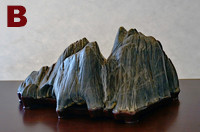Suiseki is the Japanese art of stone appreciation. Special stones are naturally formed over time by wind and water which make them take on unique shapes which can remind us of other natural objects. Suiseki can be displayed on their own or be used as an accent to complement a bonsai tree. The stones are traditionally classified into several groups of styles such as ‘figure’, ‘mountain’, ‘waterfall’, etc.
Waterfall Style Suiseki
Provided in collaboration with BSUNY member, Les Allen
This Suiseki Study Group article will feature Taki-Ishi or Waterfall Stones. Taki-Ishi (Waterfall stones) are those stones that resemble mountains with one or more waterfalls. The waterfalls are suggested by streak of white mineral at top of stone, coming down front. There are many varieties of Taki-Ishi like many different waterfalls are in nature*:
- Thread-waterfall stones (Itodaki-ishi) Suggested by a thin line of quartz-like material running down the front of the stone.
- Sheet-waterfall stones (Nudodaki-ishi) Broader lines of light-colored material coming down the front side of the stone.
- Dry waterfall stones (Karedaki-ishi) Definite markings that suggest a dried waterfall.
- Mountain waterfall stones(Yamagata-taki-ishi) Mountain stones with one or more waterfalls appearing on their front surfaces.
- Mountain-stream stones (Keiryu-seki) Stream running through valley, often white mineral vein where the stream would be. Ideal if stream runs diagonally, vs. from front to back.
Source: The Art of Stone Appreciation by Vincent T. Covello & Yuji Yoshimura
Les Allen, long time member of the Bonsai Society of Upstate New York and avid Suiseki collector for more than 20 years, is sharing with us three of his favorite waterfall stones:



The first stone (A) its a Waterfall stone that will be exhibited later this month at the Golden State Bonsai Convention in Sacramento. The stone was collected years ago with Felix Rivera during forest fires at the Salmon River.
The second (B), a Ligurian waterfall stone, was the grand prize winner at the recent AIAS convention held in Bodeno Italy. Tom Elias was the judge.
The third stone (C) its a Mountain Stream Stone that was exhibited at the recent 5th US National Bonsai Exhibition in Rochester. It was on loan from the National Arboretum. This Mountain Stream Stone comes from the Kibune river, Kamogawa tributary, north of Kyoto (Kibnue keiryu-seki). This is a very famous stone in Japan. It incorporates several excellent features such as the high peak, large plateau and well formed dimensions from front to back. The dark color gives it a sense of timelessness. An additional feature is the white stone which is located in such an ideal position that one can almost hear the roar from the rugged, rocky river. It has appeared in Japanese monthly publications devoted to viewing stones and was exhibited at the bonsai and suiseki exhibition during EXPO ’70. Donor was Mr. Kunizo Motoki.
